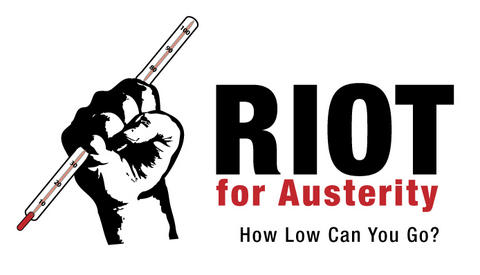We have decided, DH and I, to try the Riot 4 Austerity. It was that whole business with Sharon’s run-in with the New York Times that finally did it: we got really upset about it and this seems the best way to address that kind of inanity.
We’re now trying to establish our baseline (starting point) for the 7 categories. For some it’s as easy as looking at the utilities bill, for others it’s more difficult, but mostly because we have never kept a tally and merely have to start doing so now.
1. gasoline consumption
The desired 90% reduction of the average American usage (500 gallons per person, per year) is 50 gallons.
When we lived in the city we had only one car, a station wagon – bought second-hand with the safety of our still-to-be-born daughter in mind. We still have that, and now another car (a sedan), because in the burbs it is impossible for me to be without a car and drop Amie off at and her up from preschool (5 x a week) and do grocery-farm stand-Farmer’s Market shopping and library (1 x a week) . There is no public transport here. The preschool, food places and library are each only 1 mile away. DH drives 3 miles to a shuttle into the city three times a week.
Add to that the occasional trip to another store, the landfill to drop off our trash and recycling, and frequent trips to visit friends and that makes us fill up each car about once a month. It’s not exact science yet, but so far we estimate:
+/- 36 gallons a month for the 3 of us = +/- 150 gallons a person a year.
As I expected, this needs a lot of work, and there is a lot of room for improvement. The cold months are here and I doubt we will ride our bikes to school/shop/shuttle when it’s freezing, let alone snowing. Still, we can consolidate drives and as soon as it is possible switch to the bike.
Here’s a tough one: air travel. It’s been so expensive lately that we haven’t been flying much – 90% of our family live across one ocean or another. But family has been flying in to see us… Should we count that? This is a really difficult issue, something but for another post.
2. Electricity
Last month we used 448 KWH.
The goal is 90 KWH per household per month.
We can’t figure out why we use this much. We used to live in a basement and had the lights on all the time, and we used almost half that amount of electricity. Here we don’t need the lights on during the day, use compact fluorescent bulbs throughout, never have lights on in rooms we’re not in, turn off computers when we’re not working on them, line dry our laundry – if not in the yard, in the dry basement next to the boiler – etc. Maybe it’s the old fridge that came with the house? The radon remediation system that we were promised uses very little? We have a power meter that you plug in in between the socket and the appliance, so we should find out soon.
3. Heating and Cooking Energy
Average US usage is 750 Gallons per household, per year. A 90% cut = 75 gallons.
We cook with electricity since there are no gas lines here.
We heat the house and the water with oil. We had one of the most efficient burners installed a month after moving in and we also had the house insulated, but we don’t know yet what our consumption is going to be. We do know we have 2 honking big black tanks with 490 gallons of oil sitting in our basement (they came, full, with the house). We are planning on having that last us 2 years, because we signed up for Chunky Chicken’s Freeze Yer Buns challenge, so we keep the day temperature at 64 F and at 58 F at night.
Our baseline?
No real idea, but let’s (over?)estimate at 500 gallons a year and we’ll find out soon.
4. Garbage
According to the numbers, the average American generates about 4.5 lbs of garbage per person, per day. A 90% reduction would mean .45 lbs of garbage.
4.5 lbs a day! It boggles the mind. Discounting recycling and all the kitchen waste that becomes compost, I think that
we make that reduction at about half a pound a person a day quite easily.
I haven’t weighed our garbage yet, but will do so from now.
5. Water
The Average American uses 100 Gallons of water per persons,p er day. A 90% reduction would mean 10 gallons.
I think we will do well here as well. We shower every other day and we make it quick, and Amie gets a bath once a week (she won’t stand for more often, abhors it!). We flush selectively and are very water conscious otherwise as well. In the garden next year we plan to have water barrels and other ingenious water saving measures in place. We’ll start keeping a tally on the water meter but for now
I estimate we use 20 gallons of water per person a day
 6. Consumer Goods
The average American spends 10K per household, per year on consumer goods. So A 90% cut is 1,000 dollars.
This is a tough one to estimate. DH insists we collectively buy only about $1000 a year. I’m not so so sure, but it’s possible. We go shopping for clothes once a year (e.g., I own 2 pairs of shoes) and I don’t do cosmetics. We get a lot of second-hand and hand-me-down children’s clothes. As for toys and books, a lot of these come from friends (thank you!) and we are frequently at the library. We shop wholesale and in bulk for many things like paper goods, etc. Furniture, garden tools and those things often come through Craigslist and Freecycle.
We’ve managed to become quite thrifty with our weak points as well: electronics for DH (he’s been eying that flat screen tv but we don’t have cable anyway) and books for myself (since taking Chile’s Quit Now challenge I have bought only a few gardening and homesteading books). So,
 I estimate that we spend $2000 per year, half on new stuff, half on second-hand.
I don’t know whether that’s a conservative estimate or not. It’ll be fun to see how well I guessed once we have more concrete numbers.
 7. Food
Oh, tough one, and the organizers seem to have had a tough time coming up with a good calculation as well. I like it that instead of sticking a dollar price on this, they have opted to tie the reductions to the percentages of
- locally (within 100 miles) and organically grown foods
- dry bulk foods transported over distances longer than 100 miles
- wet goods transported over distances longer than 100 miles.
The idea is to bring the percentage of (1) up and to lower the parts of (2) and (3). Ideally, one’s food purchases should be (1) 70%, (2) 25% and (3) 5%.
During the growing season I shop for most of our veggies and fruits at the Farmer’s Market and at a farm stands right nearby. All that has closed down now, and we were too late to sign up for the winter CSA’s. Our town only has only one supermarket: Whole Foods. Going anywhere else means more gas mileage. WF is expensive, but we are careful when we go there. We seek out the local produce (keeping in mind that WF does dare to call “New York State” “local”in Eastern Massachusetts). We also think twice before buying exotic foods such as kiwi’s and mangoes, and often stick to apples. We buy our cereals, grains and flour from the bulk section (and use paper bags), but more at wholesalers like BJ’s if they have the organic kind. We have cut down substantially on meat (and often buy that local) and fish and make our own pizzas. Our major vices are coffee and tea.
I would estimate for now that our percentages are (1) 50%, (2) 35% and (3) 15%.
There is much scope for reducing (2) and (3). We’re working on our garden and as of this summer, we’re counting on being more or less self-sufficient for veggies. We’re also going to can and freeze, and install a root cellar so we can get by next winter. Other more short-term projects are to bake our own bread again and to revisit (with the town) the possibility of keeping chickens.
I plugged all this into the calculator (so cool!) and this is what our baseline looks like:


Update on WATER
I found the water meter reading from when we bought the place at the beginning of May. We only moved in at the end of June, but we’ve had house guests – sometimes 1, mostly 2, and sometimes 3 – for most of the time since then, so I will let those even out and count the numbers for just the 3 of us.
Turns out we consumed 1418 cubic metres in 6 months = 1768 gallons for the 3 of us per month = 589.3 gallons per person per month = 20% of the US national average.
That’s not bad but we should be able to reduce that.
(My estimate of 20 gallons a person a day wasn’t too far off!)
Update on HEATING OIL
DH explained to me the workings of our boiler and I went down there to take a reading.
Since its installation on 24 July, the boiler has run 66 hours. Each hour it runs it consumes .85 gallons of oil. So in 3 months we have consumed 56.1 gallons of oil. That is 30% of the US national average but pretty bad still, considering the coldest months are still ahead of us.
I wonder how to bring that down? We’re already Freezing our Buns!
Can we save on the hot water, which is heated with the same boiler/oil? We always do laundry with cold and use little water as it is, hot or cold…